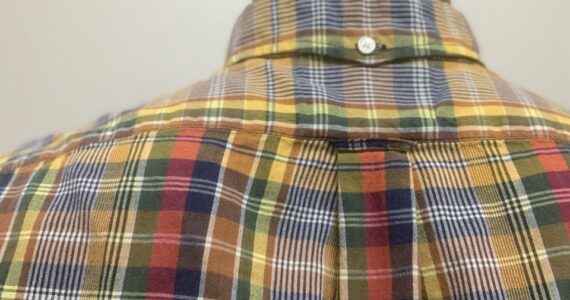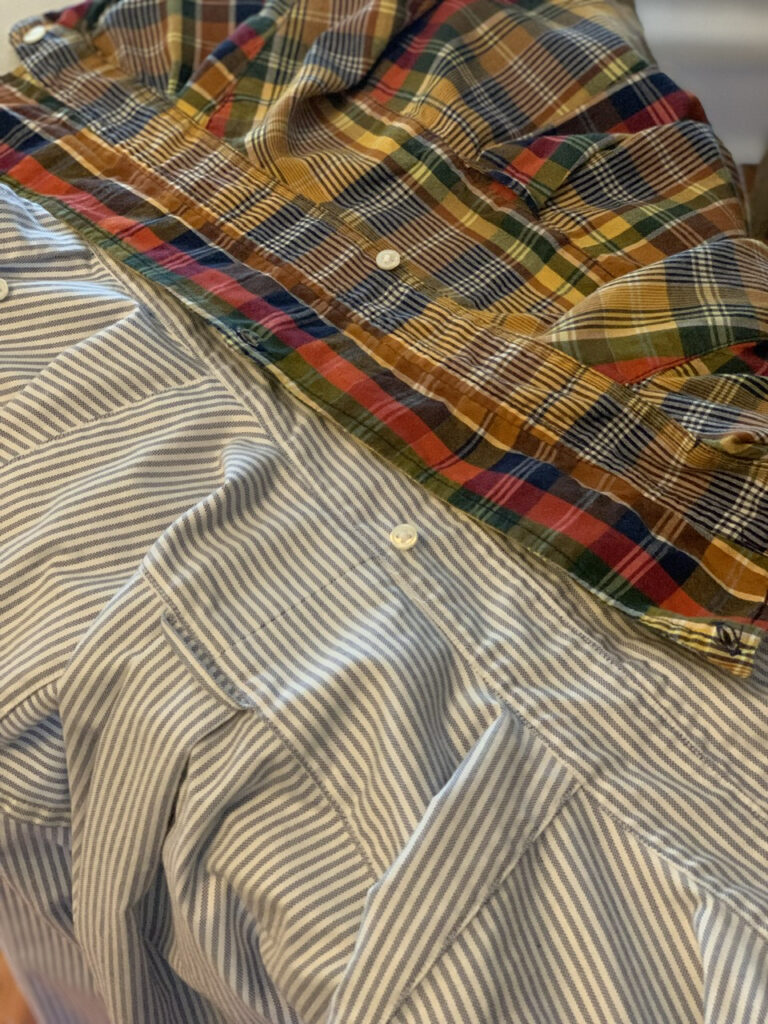This article is from The Gastonia [North Carolina] Gazette for Sunday, November 7, 1965 and was re-posted on AAT by member Charles Dana. I have my own thoughts on both the back collar button and locker loop that I will be sharing in an upcoming post.
Two simple things that practically go unnoticed on some men’s shirts are causing monumental concern in the apparel industry. A button and loop on the back side of traditional shirts have many producers losing sleep and pacing the floor. REASON: To leave them on or take them off.
For the past decade, a rear collar button and a hanger loop have become standard equipment on shirts styled in the traditional pattern. They have become accepted, taken for granted, and ignored. But now comes along one of the major traditional shirt houses in the nation and says buttons and loops will cease to be on their future models.
The stir this revelation caused was akin to jamming the panic button. Contemporary firms were taken by surprise, uncertain if this was a right or wrong move. Many are still trying to decide. Gant shirtmakers, the best-known traditional shirtmaker in America, touched off the wave of restlessness. This would seem reasonable since the firm pioneered in the field of button-down collars, back-side buttons, loops, and box pleats; plus the tapered waist. Gant led and others followed. But following the leader doesn’t come so easily when a loss of business is a likely possibility. The big question coming to mind with manufacturers was simply this: ‘How will the young man react? Since this kind of business is directly pitched at the collegiate and high school set, such a query had to be resolved, else what appears to be a good move could easily turn into a bad move.
“What would be the reaction to a change? In the Carolinas, often called the Island of Natural Shoulder History, removal of both the button and loop wouldn’t cause a ripple. For, as some store men say, nobody is looking for either one any more. Samplings around the two states of stores reveal that a general feeling of ‘not important’ is being attached to both horns of the dilemma. Tommy Frederick, furnishings manager at Matthews-Belk Co., who cut his teeth on Ivy League clothes, opines: ‘I don’t think the removal of either or both will make or break a sale. If the shirt has color, fabric, name, and quality, it will sell. This feeling was reflected in areas from Raleigh, a hotbed of traditionalism, to Charleston, S. C. The consensus of opinion was that both were first introduced as fads and this has since run its course. At the same time some stores point out that while the button serves no real purpose, the loop does. You can hang up a shirt by it. So…retailers would prefer keeping the loop.
Men who have made studies in this area of apparel say the change was inevitable. Labor costs for the two operations run into six figures for many companies. Dropping them could direct attention to other areas of shirts that need improvements–like longer tails, better and more secure buttons…. The only objections to removal came from the high school set that goes steady. It seems that a boy wearing a shirt unbuttoned at the back is going steady. That means hands off.



I don’t think they’re essential, I’ll occasionally wear button downs without the loop and collar button, but I do prefer shirts to have them and it is something I look for specifically when buying shirts…
Just checked; I have a half dozen OCBDs with lock loops on them (none have back of the collar buttons). These shirts are by IZOD, strictly for casual wear. The collars measure 2.75 inches (8.2cm) and have no roll. I’ve never worn one with a tie. Never tucked it in. I wear them mostly in the spring and the fall with chinos or jeans, unbuttoned, sleeves rolled up.
Great find and thanks for sharing! My Brooks Bros OCBD does have the loop and the button. J Crew? Not so much. I love how much handwringing went on over these decisions 60 years ago. Now, most people just throw on baggy athliesure and call it good.
I dont always button the back, but I like it there with the loop.. I also like buttoned breast pocket, but have never opened it
Hi Jarrod, did these musings come from a recent session at the ironing board aha? I do think that this is one of those Ivy rather then Trad details to be honest. e.g. for a leisurely mid orange or aqua blue OCBD these details would really complete the shirt.
But for Trad dressing which requires a more formal smarter approach to shirting like white OCBDs, white and light blue university striped shirts etc. It’s less important as the colour and shape of the collar do more to effect the shirts formality, which makes the shirt more “buisness appropriate” and thus more Trad and grown up.
Hi Jerrod, Very good. Looking forward to your post on this. I had read somewhere that the back button was an attempt to keep the ultra thin ties of the mid 1950s through early 60s, from riding around the collar too much. Not sure if that is really the case (see below). Obviously, locker loops served a purpose, much like the loop inside of suit jackets (never felt right using those but I have hung many a locker looped shirt by that loop in a gym locker).
I have a number of madras Gant shirts from the 1960s, with both the back button and locker loop, as well as a long sleeve, plain weave cotton “Shapley University Club” shirt with those details. I have one Gant shirt that is “durable press” button down, probably from late 60s or early 70s, and there’s neither loop nor rear button.
Of course, all my Lands’ End Sail Rigger OCBD shirts have both the locker loop and rear button. I actually wear those a lot with ties (and my ties are all vintage, ranging from 1.75” to 2.5”. I never can use the back button with them, so unless I’m wearing the shirt tieless, the the back button is unfastened. Cheers!
What a delightful bit of style journalism ephemera. I’m a fan of the locker loop — it’s actually quite useful. The center button at the back of the collar, though, is kind of tedious and annoying when a tie is involved. J. Press still puts in the center button, and I don’t mind it, only because they’re J. Press. The locker loop is missed on my Brooks shirts, but I don’t mind because I really love wearing them anyway.
In the articled reprinted above, a manager in the retail clothing industry states that the consensus was that the locker loop and back collar button were “introduced as fads.” That’s evidently true; with at least one exception that I found (and there may be more), the back button was marketed simply as one of the features that helped to make a shirt authentically “Ivy.” The third button generally was not promoted as a utilitarian feature that held the necktie in place. Indeed, even shirts that were explicitly advertised as casual—with no expectation that they would be worn with a necktie—had the back collar button. Anyway, with dress shirts, it would usually have been impossible to fasten the back collar button because the length of tie inside the back of the collar would have gotten in the way. (Curiously, a lot of the ads don’t mention the locker loop. Since its utilitarian nature was obvious, perhaps it was taken for ganted.)
Examples of marketing flapdoodle:
In the San Francisco Chronicle on December 22, 1958, a clothier advertised a product this way: “Ivy sportshirt with all the important Ivy features: button down collar, button in back, and box pleated back. Comes in printed patterns with long sleeves, 5.95.”
An ad for Gant’s line of short-sleeve, buttondown pullover shirts for boys appeared in the San Francisco Chronicle on June 13, 1959. It reads as follows [keep in mind that the Beatnik craze was at its pinnacle in 1959]: “Here’s a duplicate of the gasser that’s been the coolest selling man’s shirt of the season! It’s the end with or without a tie. Has all the Ivy jazz…button down collar, button in back and box pleat. In these crazy colors: white, blue, navy, linen and olive.”
And an ad for Gant shirts in the August 24, 1959 SF Chronicle: “Authentic Ivy Oxford pullover. Button down collar, button in back and box pleat. In white, blue, navy and linen.”
In December 1959, a retailer in the Chronicle touts the Gant shirts on offer as being “Authentic Ivy” pullovers, made of “fine oxford cloth with button down collar, button and pleat in back.”
In ads in the Chronicle in 1961, Gant shirts, what with the box pleat and collar button in the back, were described as being a “Synonym for Ivy” and “incorruptibly correct.”
So forget any supposed practical function of the back collar button. It was (and is) there as an element of pure style (and serves as a convenient marketing gimmick). It’s “Ivy jazz” as one of the ads quoted above put it. That button exists because it’s expected to exist. Come to think of it, if you review how various other garments associated with the Ivy League were promoted from the 1930s to the 1960s (even though the term “Ivy League” didn’t become an explicit selling point for clothes until about 1954), you’ll notice how often the advertisements assured impressionable young consumers that some item or other was “correct.”
I mentioned that I had found an exception whereby the back collar button was promoted as being more than just a stylistic doodad. “bruce bary” was the name of a highly-regarded San Francisco clothing store that catered to men, including very young men. It sold garments that had been manufactured to its own specifications. On May 17, 1963, bruce bary ran an ad in the SF Chronicle for a shirt that had a locker loop and back collar button. It went like this: “There is absolutely no use for the loop on this bruce bary shirt! Except in the locker room (athletes love it). So will you. All bruce bary shirts have plus details like the back collar button to keep your tie straight…and the box-pleated back for trim fit and comfort….” And the back button probably was useful in keeping the tie in place, inasmuch as the collar band was rather wide and the button and buttonhole were very close to the bottom edge of the collar; the fastening point would have been below the strip of necktie inside the back of the collar. But the bruce bary shirt seems to have been an outlier.
“Ivy jazz.” Good terminology. That’s essentially what we’re dealing with here.
Very interesting! Thanks for sharing your research, Charles!
Jerrod, I have a question for you about the back of collar button detail.
Would you ever consider a MTM/Bespoke shirt with two buttons on the back of the collar? This would feature on a taller rather then a shorter collar stand?
Thanks
Tie Clip, I would probably stick with 1 were I to add a back collar button. Primarily because I think it would be pretty busy and maybe a bit of a novelty which is funny because of the topic. If you do it please keep us posted on how it turns out!
You’re welcome!